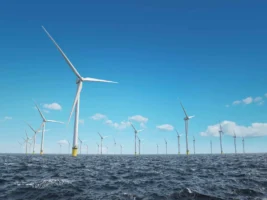UK billionaire Sanjeev Gupta says that the ACCC proposal for the federal government to underwrite new “firming” capacity could help drive down the cost of solar in Australia to prices as low as $20/MWh, and no more than $50/MWh with back-up.
Gupta on Wednesday unveiled the first of his planned one gigawatts of “dispatchable” renewable capacity – to power the Whyalla steelworks and other major users – at a ceremony at the site of the first project, a 280MW solar plant at Cultana near Whyalla.
This will be followed in the next year or two by yet more solar capacity, plus what would be the world’s biggest lithium-ion battery (120MW and 140MWh) near Port Augusta and a pumped hydro facility located in old iron ore mines in the nearby Middleback Ranges.
Gupta’s plans for solar go much further than that – and he has outlined a vision for up to 10GW of solar capacity across the country to restore Australia’s position as a cheap energy producer with a strong manufacturing base.
“There is no doubt in my mind that Australia should be cheapest solar energy producer in the world,” Gupta told RenewEconomy in an interview on Thursday.
He pointed to recent contracts in the Middle East and India in the mid $US20s/MWh, and said this was underpinned by access to cheap land, cheap finance and lower construction costs.
Ironically, he said his vision to “solarise” the Australian economy could be accelerated by the proposal from Australian Competition and Consumer Commission chairman Rod Sims for the federal government to “underwrite” new firming capacity in the market.
The Turnbull government has indicated it will adopt this idea, although many commentators, and many in the Coalition government, see this as an opportunity to bring in new coal-fired power stations – despite a virtually unanimous view in the energy industry that new coal makes no economic, or environmental sense.
Please read David Leitch’s analysis of the chances of a new coal generator here.
Gupta, on the other hand, sees the auction as an opportunity to bring down the cost of solar, because the government underwriting commitment – providing a minimum return of around $45-$50/MWh to a new project from years 5 onwards – would lower the cost of finance.
“That would allow us to borrow at around government rates,” Gupta says. “We have seen similar programs in the UK …. and if construction costs can also be brought down, we can get solar to below the cost of the Middle East because Australia has a much better solar resource.”
Gupta says that even with firming capacity, the package of “reliable” and “dispatchable” solar should be brought down to the $40-$50/MWh range. “That is half what we are paying now,” he says.
“We think solar is cheapest energy option. It is not enough by itself, we need solutions for the non solar hours, but we are working on those” with the addition of battery storage, pumped hydro and financial contracts.
The devil will be in the details of any government tender. But one of the key criteria will be that it is built by a “new competitor” i.e. not one of the current big gentailers. Gupta’s majority owned retailer Simec Zen Energy fits that bill, and with Gupta it has deep pockets.
Gupta says that most businesses in Australia were not interested in political debates around fossil fuels and renewables, they simply want access to the cheapest supply. It’s just that he has no doubts that renewables are the cheapest.
“To be honest, business doesn’t want to be involved in these issues – they just want the cheapest energy, they want the cheapest bill.”
Gupta’s Simec Zen Energy has already contracted to supply the South Australia government, and recently did the same with half a dozen businesses that pooled their energy needs through a tender conducted by the South Australia Chamber of Commerce and Mines.
The majority of these electricity demands will be met through renewables, such as with solar farms contracted in the eastern states, and financial contracts, and then with the solar and storage capacity that will be built over the next few years in South Australia.
“I think the price of electricity (for big consumers) can be brought back to historic levels of $50/MWh and $60/MWh,” Gutpa told RenewEconomy.
“We will be doing this by generating the cheapest energy – and the cheapest combination we have found is solar and other forms of generation (storage) in South Australia.”
Gupta also confirmed his intention to establish a manufacturing plant of “low cost” electric vehicles in Australia, although he said he had nothing new to announce on the site location.
Gupta had originally targeted South Australia but has also raised the possibility of siting the facility in Victoria, which was also a major host of Australia’s now defunct car manufacturing industry, and retains significant resources and expertise.
“It is still the status quo – we are 100 per cent behind it, we are absolutely certain we are going to do it. There are a lot of discussions going on,” he told RenewEconomy.
“We hope to be in production in a couple of years – 2-3 years.”









